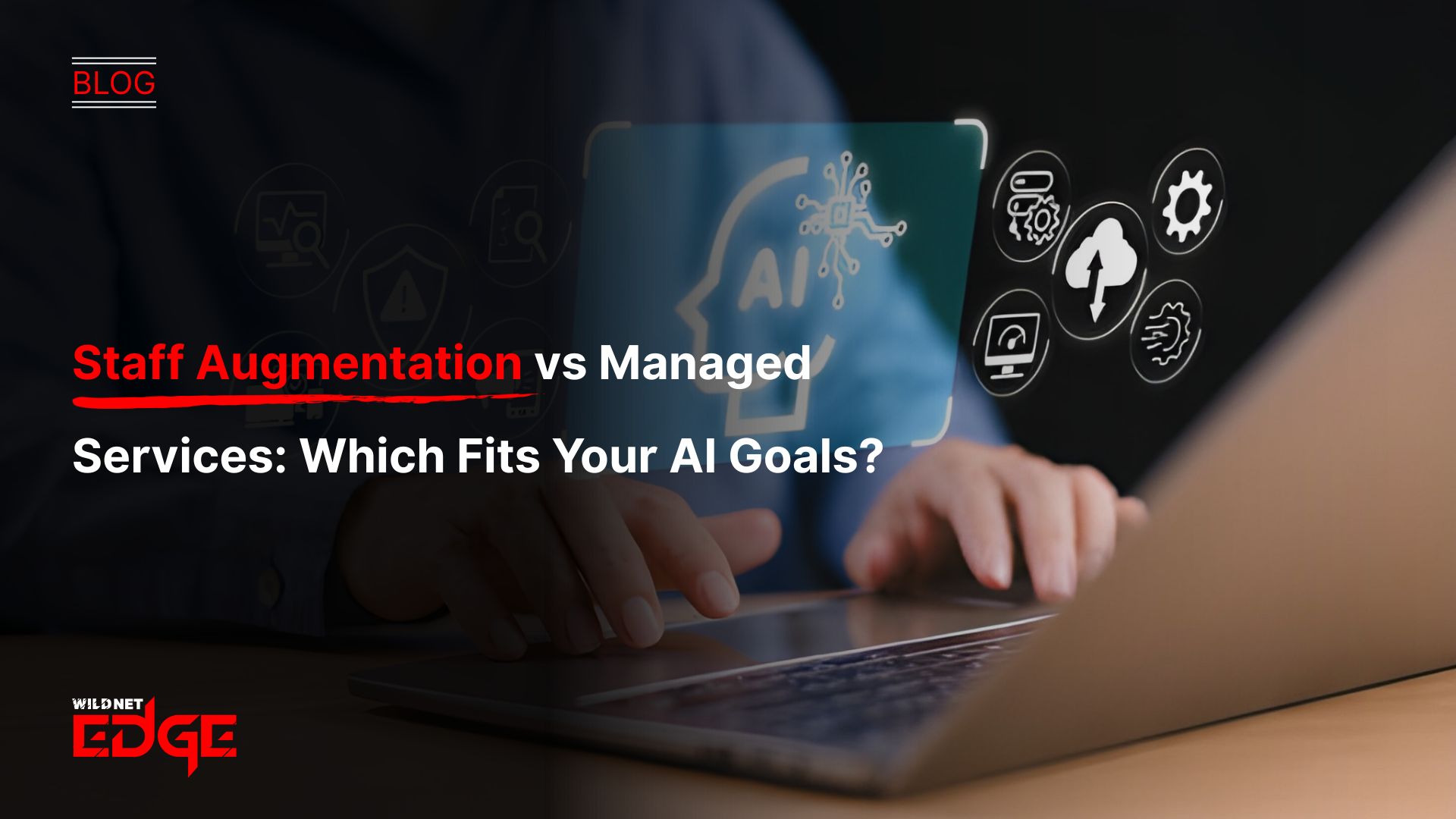TL;DR
This article compares AI staff augmentation and managed services, outlining their pros, cons, and ideal use cases. Staff augmentation adds external AI experts to your team for flexibility and control, while managed services outsource entire AI projects for end-to-end delivery. It helps businesses choose the best AI staffing model based on cost, speed, expertise, and internal capacity
AI staffing models are reshaping how businesses build and scale their artificial intelligence capabilities in today’s fast-evolving tech landscape. From startups experimenting with machine learning to enterprises implementing full-scale AI transformation, choosing the right staffing model can make or break project success. Whether it’s augmenting your in-house team with specialized AI talent or outsourcing entire projects through managed services, understanding these models helps organizations balance control, cost, and expertise for smarter, faster innovation.
Understanding the AI Staffing Models
Let’s define the two primary approaches for AI services staffing:
Staff Augmentation
- Concept: You temporarily add external technical experts to your existing internal team. These individuals work under your direct management and integrate into your ongoing projects and workflows.
- Analogy: Hiring specialized contractors to join your construction crew for a specific phase of a building project, working under your foreman’s direction.
- Focus: Filling specific skill gaps within your team for a defined period.
Managed Services
- Concept: You outsource an entire project, function, or outcome to a specialized third-party vendor. The vendor takes full responsibility for managing the team, processes, deliverables, and achieving the agreed-upon results (often defined by Service Level Agreements – SLAs).
- Analogy: Hiring a general contractor to build the entire house, responsible for managing all subcontractors and delivering the finished building according to the blueprints.
- Focus: Delivering a complete solution or managing an ongoing function with guaranteed outcomes.
Staff Augmentation vs Managed Services: Which One Should Choose ?
The “best” choice depends entirely on your specific needs. This AI talent model comparison highlights the key differences:
| Factor | Staff Augmentation | Managed Services |
| Control | High (Direct management of resources) | Lower (Focus on outcomes, vendor manages resources) |
| Cost Model | Typically Time & Materials (Hourly/Monthly rate per resource) | Often Fixed Price (Project) or Outcome-Based (SLA-driven) |
| Speed (Start) | Faster (Adds specific skills quickly) | Slower initial setup (Scope definition, SLA negotiation) |
| Expertise | Fills specific gaps | Provides end-to-end expertise & process maturity |
| Management | High internal management overhead required | Lower internal overhead (Vendor manages project/team) |
| Risk | Shared (You manage project risk) | Primarily Vendor’s (Vendor guarantees outcomes/SLAs) |
| Integration | High (Resources integrate directly with your team) | Lower (Often operates more independently, defined touchpoints) |
When to Choose Staff Augmentation for AI
Staff augmentation is often the preferred AI staffing model when:
- You have a strong internal AI/technical team and leadership: You possess the core expertise and project management capabilities but need specific, temporary skills e.g., an expert in Natural Language Processing for a 6-month project.
- You need maximum control and integration: The external resources need to work extremely closely with your internal team on a daily basis within your existing processes. This model is often used in custom software development for AI teams.
- Requirements are fluid and evolving rapidly: A Time & Materials model allows for flexibility as project needs change.
- You need to quickly scale up capacity for a specific phase: Adding developers for a crunch period before a major launch.
When to Choose Managed Services for AI
Managed services are often the better choice when:
- You lack significant in-house AI expertise or management bandwidth: You need a partner to provide not just talent but also process, strategy, and accountability for outcomes. This is a common scenario for engaging an AI development services partner.
- The project scope and desired outcomes are clearly defined: Suitable for fixed-price projects where deliverables can be specified upfront.
- You want predictable costs and guaranteed results: Managed services often operate under SLAs that guarantee performance or specific outcomes.
- You need end-to-end responsibility: From initial design and development to ongoing maintenance and optimization of an AI system. This can be crucial for complex projects like enterprise app development staffing.
Hybrid Models: The Best of Both Worlds?
It’s also common to use a hybrid approach. You might have a core internal AI team defining strategy and managing key projects, while using staff augmentation to fill temporary skill gaps and engaging managed services for specific, well-defined functions (like ongoing model monitoring or infrastructure management). Leveraging external expertise for areas like devops & cloud engineering augmentation alongside internal teams is a frequent hybrid strategy.
AI Staffing Models in Action: Case Studies
Case Study 1: An eCommerce Retailer (Staff Augmentation)
- The Challenge: A large online retailer had a strong internal data science team but lacked specific expertise in computer vision to develop a new visual search feature.
- Our Solution: We provided two senior computer vision engineers via staff augmentation. They joined the retailer’s existing agile team, reported to their internal tech lead, and collaborated closely to build and integrate the new feature over nine months.
- The Result: The retailer successfully launched the visual search feature, leveraging specialized external talent without the long-term cost of hiring full-time specialists. The staff augmentation model provided the perfect blend of expertise and integration.
Case Study 2: A Manufacturing Company (Managed Services)
- The Challenge: A mid-sized manufacturing company wanted to implement an AI-powered predictive maintenance system for its factory floor but had no in-house data science or MLOps expertise.
- Our Solution: They engaged us for a managed services project. We took end-to-end responsibility: defining the requirements, building the data pipelines, developing the predictive models, deploying the system, and providing ongoing monitoring and retraining under an SLA.
- The Result: The managed service successfully reduced unplanned downtime by 30% within the first year. The company gained the benefits of advanced AI without needing to build an internal AI department, allowing them to focus on their core manufacturing business.
Our Technology Expertise
We provide talent and manage projects across the AI spectrum.
- AI/ML Frameworks: TensorFlow, PyTorch, Scikit-learn, Keras
- Cloud AI Platforms: AWS SageMaker, Azure Machine Learning, Google AI Platform
- Data Processing: Apache Spark, Databricks, Snowflake
- MLOps: Kubeflow, MLflow, DVC
- Programming Languages: Python, R, Java, Scala
Conclusion
Choosing between staff augmentation vs managed services is a critical strategic decision when implementing AI. There is no single right answer; the optimal AI staffing model depends entirely on your organization’s internal capabilities, project requirements, budget, and tolerance for risk. By carefully evaluating these factors, you can select the approach that best accelerates your AI initiatives and delivers tangible business value.
Ready to build your high-performing AI team? At Wildnet Edge, our AI-first approach informs how we structure engagements. We offer flexible AI services staffing models, from expert augmentation to end-to-end managed solutions, ensuring you have the right talent and strategy to succeed.
FAQs
Staff augmentation is typically priced per resource per hour/month, making costs variable based on duration. Managed services are often priced per project (fixed fee) or based on outcomes/SLAs, offering more budget predictability but potentially a higher overall cost for the guaranteed result and included management.
Staff augmentation can be faster to start if you just need to add a specific skill quickly to an existing project. However, a managed service might deliver the final outcome faster if the vendor has a highly optimized process and pre-built components, especially if you lack internal project management for AI.
For staff augmentation, ensure augmented staff work closely with internal team members and document their work thoroughly. For managed services, require comprehensive documentation, regular knowledge-sharing sessions, and potentially define a transition plan in the contract if you intend to take over management later.
Staff augmentation (using a Time & Materials contract) generally offers more flexibility to adapt to changing requirements, as you are directing the resources day-to-day. Managed services (especially fixed-price) require more upfront scope definition and typically involve a formal change request process for significant alterations.
Quality is ensured through clearly defined Service Level Agreements (SLAs) and Key Performance Indicators in the contract. Specify the exact outcomes, performance metrics, uptime guarantees, and reporting requirements you expect the vendor to meet.
While often used for specific projects, staff augmentation can be used long-term to supplement your team with specialized skills that are hard to hire or only needed periodically. However, relying heavily on augmentation long-term can sometimes hinder the development of internal core competencies.
The first step is a clear internal assessment. Honestly evaluate your in-house AI expertise, project management capabilities, budget constraints, risk tolerance, and the specific goals of your AI initiative. This internal clarity will make it much easier to determine whether staff augmentation, managed services, or a hybrid approach is the best fit.

Nitin Agarwal is a veteran in custom software development. He is fascinated by how software can turn ideas into real-world solutions. With extensive experience designing scalable and efficient systems, he focuses on creating software that delivers tangible results. Nitin enjoys exploring emerging technologies, taking on challenging projects, and mentoring teams to bring ideas to life. He believes that good software is not just about code; it’s about understanding problems and creating value for users. For him, great software combines thoughtful design, clever engineering, and a clear understanding of the problems it’s meant to solve.
 sales@wildnetedge.com
sales@wildnetedge.com +1 (212) 901 8616
+1 (212) 901 8616 +1 (437) 225-7733
+1 (437) 225-7733































